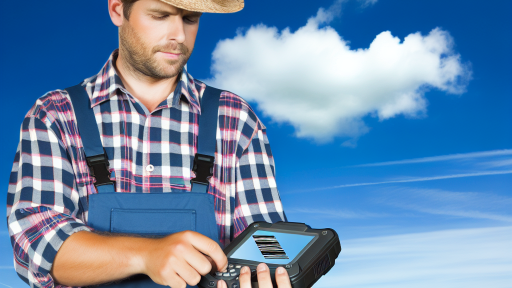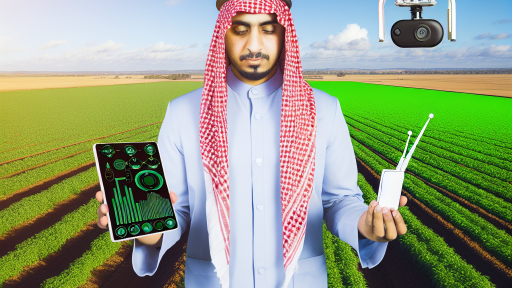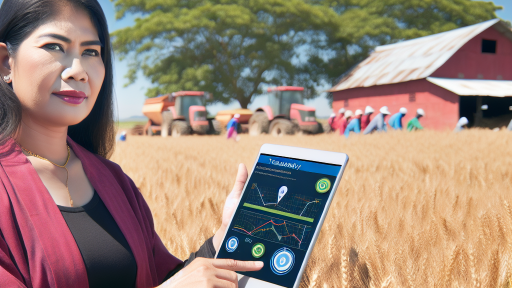Introduction to Crop Disease Detection
Importance in Modern Agriculture
Crop disease detection plays a crucial role in agriculture today.
Farmers face significant challenges with crop diseases worldwide.
These diseases can severely reduce yield and affect food security.
Effective detection methods help mitigate losses and ensure productivity.
Innovative technologies enable prompt identification of diseases.
This speed enhances farmers’ ability to manage their crops effectively.
Additionally, accurate detection helps in minimizing pesticide usage.
As a result, it promotes sustainable farming practices.
Farmers can make informed decisions based on real-time data.
Modern technologies revolutionize traditional farming approaches.
These advancements lead to healthier crops and better harvests.
Investment in research and development is essential for progress.
Robust disease detection systems drive agricultural efficiency forward.
Improved crop disease detection is vital for future farming.
Overview of Innovative Technologies in Crop Disease Detection
Introduction to Crop Disease Detection Technologies
Crop diseases threaten food security and farmer livelihoods.
Transform Your Agribusiness
Unlock your farm's potential with expert advice tailored to your needs. Get actionable steps that drive real results.
Get StartedInnovative technologies aid in early detection and management.
These advancements use data analytics and precision agriculture tools.
Remote Sensing Techniques
Remote sensing plays a significant role in monitoring crops.
This technology uses satellites and drones to gather data.
Farmers can quickly identify areas affected by diseases.
Remote sensing improves crop management decisions.
It allows for targeted treatments, minimizing resource waste.
Machine Learning and Artificial Intelligence
Machine learning algorithms analyze vast amounts of crop data.
This technology identifies patterns and anomalies effectively.
AI-powered systems offer predictive insights for disease outbreaks.
Farmers receive recommendations based on real-time analysis.
These insights enhance overall crop health management.
Mobile Applications
Mobile applications have simplified disease detection for farmers.
Farmers can capture images of crops for diagnosis.
Many apps provide instant feedback about potential diseases.
Furthermore, they offer treatment suggestions to combat issues.
This accessibility empowers farmers with immediate support.
Biological Indicators
Biological indicators offer another layer of disease detection.
Soil health assessments reveal potential crop diseases.
Pests and microbes often signal underlying plant stress.
Analytical tools can assess soil and plant samples.
This approach allows for proactive crop management strategies.
Transforming Crop Disease Management
Integrating these technologies transforms crop disease management.
Farmers are better equipped to face agricultural challenges.
Showcase Your Farming Business
Publish your professional farming services profile on our blog for a one-time fee of $200 and reach a dedicated audience of farmers and agribusiness owners.
Publish Your ProfileUltimately, these innovations contribute to sustainable farming practices.
This progress ensures food security for future generations.
Role of Remote Sensing in Identifying Crop Diseases Early
Introduction to Remote Sensing
Remote sensing technology uses satellite and aerial imagery.
This technology provides valuable data about crops and vegetation.
Farmers can monitor large areas quickly and efficiently.
Additionally, it helps in gathering data on environmental conditions.
Benefits of Early Detection
Identifying crop diseases early is crucial for farmers.
Timely detection can significantly reduce crop losses.
It allows for prompt interventions to control disease spread.
Early actions can improve overall crop health and yield.
How Remote Sensing Works
Remote sensing utilizes various sensors to capture images.
These sensors can detect specific wavelengths of light.
Diseased crops often reflect different light patterns compared to healthy ones.
By analyzing these patterns, farmers can identify potential issues.
Advanced Techniques for Disease Detection
Machine learning algorithms interpret remote sensing data.
These algorithms learn to recognize disease symptoms automatically.
Furthermore, artificial intelligence enhances prediction accuracy.
Consequently, farmers receive actionable insights rapidly.
Real-World Applications
Many companies utilize remote sensing for disease management.
For instance, AgriTech Solutions offers satellite imagery services.
Their platform alerts farmers about emerging disease threats.
Additionally, Precision Farming Inc. provides integrated remote sensing tools.
Challenges in Implementation
Despite its advantages, remote sensing has challenges.
The cost of technology can be a barrier for small farmers.
Moreover, data interpretation requires expertise and training.
Farmers must be willing to adopt new technologies.
Future Prospects
The future for remote sensing in agriculture looks promising.
Advancements in technology will enhance detection capabilities.
More farmers are likely to embrace these methodologies.
Ultimately, this technology may revolutionize crop disease management.
See Related Content: Biomass Digesters for Renewable Farm Energy Production
Use of Machine Learning and AI in Analyzing Crop Health Data
Introduction to Machine Learning in Agriculture
Machine learning transforms agriculture into a more data-driven field.
It helps farmers make informed decisions based on precise data analysis.
This technology identifies patterns in crop health data efficiently.
AI Algorithms for Disease Detection
Advanced AI algorithms play a pivotal role in plant disease detection.
These algorithms analyze photographs of crops to spot anomalies.
As a result, early intervention becomes possible.
Data Collection Techniques
Remote sensing technologies gather crucial crop data.
Drones equipped with high-resolution cameras capture images of fields.
Moreover, sensors placed in fields monitor soil conditions in real time.
Showcase Your Farming Business
Publish your professional farming services profile on our blog for a one-time fee of $200 and reach a dedicated audience of farmers and agribusiness owners.
Publish Your ProfileAdvantages of Using AI in Crop Health Analysis
AI improves the accuracy of disease detection significantly.
Consequently, it minimizes the reliance on chemical treatments.
Farmers can focus on sustainable practices that promote healthier crops.
Case Studies of Success
Several farms have successfully implemented machine learning solutions.
For instance, Green Valley Farms reported increased yield rates.
In addition, they noted a reduction in crop loss due to diseases.
Future Prospects
The integration of machine learning in farming is just beginning.
As technology advances, we can expect even greater improvements.
Farmers worldwide will likely adopt these innovative solutions.
You Might Also Like: Improving Soil Health With Agricultural Biotechnology
Benefits of Using Drones for Real-Time Surveillance and Disease Detection
Enhanced Crop Monitoring
Drones provide comprehensive monitoring of crop health.
They capture high-resolution images in real-time.
This real-time data allows for immediate analysis and action.
Early Disease Detection
Drones excel in identifying disease symptoms early.
Early detection prevents widespread crop damage.
This capability significantly reduces potential losses.
Cost-Effective Solutions
Utilizing drones can lower labor costs dramatically.
As a result, farmers can allocate resources more efficiently.
Additionally, drones minimize the need for frequent field visits.
Improved Data Accuracy
Drones provide precise data collection compared to traditional methods.
This accuracy enhances decision-making regarding crop management.
Basing decisions on reliable data encourages better outcomes.
Real-Time Response Capability
Drones enable rapid response to emerging issues.
This capability is crucial for managing pest outbreaks.
Consequently, farmers can implement protective measures quickly.
Integration with Advanced Technologies
Drones integrate seamlessly with AI and machine learning tools.
This integration enhances data analysis and predictive measures.
Farmers gain insights that inform their cultivation practices.
Find Out More: Smart Contracts And Blockchain Transforming Farming Agreements
Case Studies of Successful Implementation of Detection Technologies
Advanced Imaging Techniques
In recent years, farmers increasingly rely on advanced imaging techniques.
Using drones equipped with multispectral cameras, they monitor plant health effectively.
For instance, GreenTech Farms implemented this technology to detect early signs of blight.
As a result, they reduced crop loss by 30% in just one season.
Machine Learning Algorithms
Machine learning algorithms offer immense potential in crop disease detection.
Agricultural Innovations Inc. developed a predictive model to analyze historical data.
This model identifies disease outbreaks before they become widespread.
Consequently, farmers gained significant insights into optimal treatment timings.
Mobile Applications and Farmer Engagement
Mobile applications empower farmers with real-time data and support.
CropGuard, an app launched by EcoAgri Solutions, assists in disease identification.
It enables farmers to upload images and receive instant feedback.
Showcase Your Farming Business
Publish your professional farming services profile on our blog for a one-time fee of $200 and reach a dedicated audience of farmers and agribusiness owners.
Publish Your ProfileFarmers report increased confidence in managing their crops since the launch.
Case Study: Sustainable Agriculture Group
The Sustainable Agriculture Group adopted a combination of technologies.
They integrated soil sensors and drone imaging to monitor crop conditions.
This approach allowed them to pinpoint disease hotspots quickly.
Ultimately, their yields improved by 25% over three growing seasons.
Community Training Programs
Training programs enhance the effectiveness of detection technologies.
Agricultural Growth Network hosted workshops in rural areas to teach farmers.
Participants learned to use software tools for monitoring crop health.
These initiatives fostered a sense of community and collaboration among farmers.
Learn More: Top Automated Machinery Solutions For Sustainable Farming

Challenges Faced in Adopting Advanced Detection Technologies
High Initial Costs
Many farmers encounter high initial costs when adopting advanced detection technologies.
Investment in equipment and training can strain tight budgets.
Additionally, some technologies may require ongoing subscription fees.
Lack of Technical Expertise
Farmers often struggle with the technical skills needed for these technologies.
Without proper training, effective utilization becomes difficult.
Moreover, a lack of local support can exacerbate this issue.
Inconsistent Data Quality
Data quality presents a significant challenge to farmers relying on detection technologies.
Poor data can lead to incorrect diagnoses and ineffective treatments.
As a result, farmers may lose trust in these technologies over time.
Resistance to Change
Farmers frequently resist changing traditional farming practices.
Deep-rooted habits can hinder the adoption of innovative technologies.
Furthermore, some may fear the unknown implications of these technologies.
Variability in Agricultural Conditions
Agricultural conditions vary widely across different regions.
What works in one area may not be effective in another.
This variability complicates the implementation of standardized detection technologies.
Integration with Existing Systems
Integrating new technologies with existing systems can be challenging.
Farmers often use a mix of old and new methods, leading to confusion.
Effective training is essential for seamless integration and operation.
Regulatory Barriers
Regulatory constraints can be a roadblock for adopting advanced technologies.
Farmers must navigate complex compliance requirements for new systems.
Ultimately, these barriers may deter innovation in the agricultural sector.
Future Trends and Potential Developments in Crop Disease Detection
Advancements in Technology
Technological innovations continue to reshape crop disease detection methods.
Artificial intelligence enhances data analysis for immediate threats.
Machine learning algorithms improve predictive capabilities significantly.
These advancements foster more accurate disease identification.
Integration of Remote Sensing
Remote sensing technology collects vital data from fields.
Farmers can monitor crop health in real-time using drones.
Sensors placed throughout fields detect early signs of disease.
This technology supports timely intervention and treatment.
Data Analytics and Big Data
Big data analytics allows for better prediction of disease outbreaks.
Showcase Your Farming Business
Publish your professional farming services profile on our blog for a one-time fee of $200 and reach a dedicated audience of farmers and agribusiness owners.
Publish Your ProfileAnalyzing historical data provides insights into disease patterns.
Farmers can make data-driven decisions for effective crop management.
Collaboration Among Stakeholders
Collaboration among researchers, agronomists, and farmers is essential.
Sharing knowledge leads to improved detection methodologies.
Partnerships can facilitate the development of tailored solutions.
Sustainable Practices and Biotechnologies
Biotechnology offers innovative solutions for disease resistance.
Integrating sustainable practices minimizes the ecosystem’s impact.
Genetic engineering provides crops with enhanced disease resistance.
Mobile and Cloud-Based Applications
Mobile applications give farmers access to disease detection tools.
Cloud-based platforms store data for collaborative efforts.
Farmers can receive real-time updates and recommendations remotely.
Educational Programs and Training
Training programs empower farmers with knowledge on disease management.
Educated farmers are better equipped to utilize new technologies.
This education fosters sustainable farming practices.
Importance of Continued Innovation in Agriculture
Addressing Global Food Security
Innovation plays a crucial role in improving food security worldwide.
With rising populations, we need to produce more with limited resources.
Advanced technologies in farming can help boost crop yields significantly.
Enhancing Resilience to Climate Change
Farming innovations enhance resilience against climate change impacts.
New techniques allow crops to withstand extreme weather conditions.
Adopting these methods reduces vulnerability to climate-related failures.
Improving Economic Viability for Farmers
Innovation can also improve economic outcomes for farmers.
By adopting new technologies, farmers can reduce costs and increase profits.
Efficient farming practices lead to better resource management.
Encouraging Sustainable Practices
Continued innovation promotes sustainable agricultural practices.
New technologies can minimize the use of harmful pesticides and fertilizers.
These practices contribute to cleaner ecosystems and healthier food.
Collaboration and Knowledge Sharing
Collaboration among stakeholders drives agricultural innovation forward.
Farmers, scientists, and technologists must share knowledge and resources.
This collaborative approach accelerates the development of effective solutions.
Future Opportunities for Growth
Innovation opens doors to new markets and opportunities for growth.
By embracing change, farmers can access valuable insights and technology.
Adapting to evolving agricultural methods ensures long-term sustainability.
Ongoing Development in Agriculture
Ongoing innovation in agriculture is vital.
Continuous advancements safeguard food production and environmental health.
Investing in technologies ensures a resilient agricultural future.
Additional Resources
Agriculture Innovation Agenda | Home
Revolutionizing American Agriculture: How Soil Science Research …




